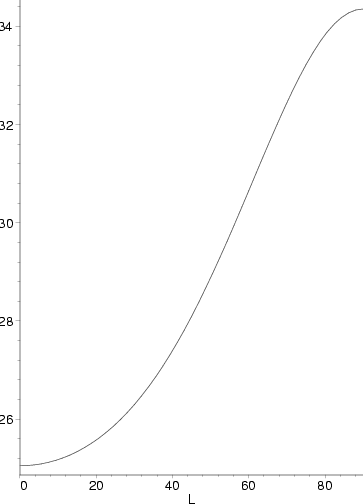Some more detail on the Sun's variable rotation rate
 Since the Sun's body is fluid, we can't be assured that all points on its
surface rotate about its axis at the same rate. And in fact, the Sun's
rotational rate varies quite a bit with latitude. The diagram to the right plots
rotational period as a function of latitude, so you can see that the period at
the equator (zero degrees latitude) is about ten days shorter than the period
near the poles (ninety degrees latitude).
Since the Sun's body is fluid, we can't be assured that all points on its
surface rotate about its axis at the same rate. And in fact, the Sun's
rotational rate varies quite a bit with latitude. The diagram to the right plots
rotational period as a function of latitude, so you can see that the period at
the equator (zero degrees latitude) is about ten days shorter than the period
near the poles (ninety degrees latitude).
However, since sunspots tend to occur mostly within about thirty degrees of
the equator, it's unlikely the kids will observe actual period differences
greater than about two days. If they really want to pursue this issue, they will
need a way to determine the latitude of the spot they are taking measurements
from. At the middle school level of mathematical knowledge, this might best be
done by visually comparing the path traced out by their spot with the lines of
latitude on a classroom globe of the earth and estimating.
 Since the Sun's body is fluid, we can't be assured that all points on its
surface rotate about its axis at the same rate. And in fact, the Sun's
rotational rate varies quite a bit with latitude. The diagram to the right plots
rotational period as a function of latitude, so you can see that the period at
the equator (zero degrees latitude) is about ten days shorter than the period
near the poles (ninety degrees latitude).
Since the Sun's body is fluid, we can't be assured that all points on its
surface rotate about its axis at the same rate. And in fact, the Sun's
rotational rate varies quite a bit with latitude. The diagram to the right plots
rotational period as a function of latitude, so you can see that the period at
the equator (zero degrees latitude) is about ten days shorter than the period
near the poles (ninety degrees latitude).